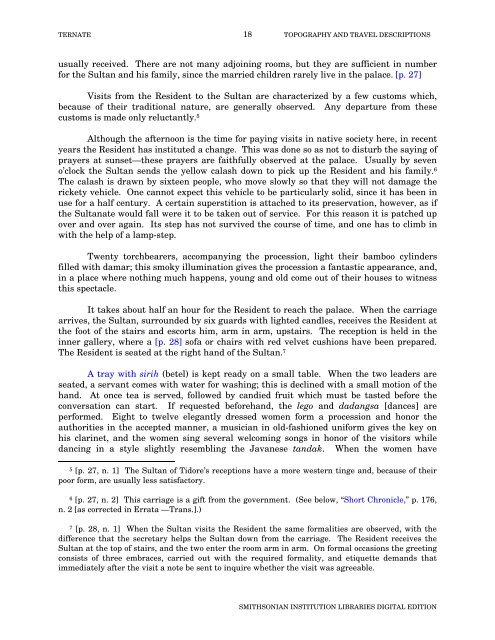Ternate - Smithsonian Institution Libraries
Ternate - Smithsonian Institution Libraries
Ternate - Smithsonian Institution Libraries
Create successful ePaper yourself
Turn your PDF publications into a flip-book with our unique Google optimized e-Paper software.
TERNATE 18 TOPOGRAPHY AND TRAVEL DESCRIPTIONS<br />
usually received. There are not many adjoining rooms, but they are sufficient in number<br />
for the Sultan and his family, since the married children rarely live in the palace. [p. 27]<br />
Visits from the Resident to the Sultan are characterized by a few customs which,<br />
because of their traditional nature, are generally observed. Any departure from these<br />
customs is made only reluctantly. 5<br />
Although the afternoon is the time for paying visits in native society here, in recent<br />
years the Resident has instituted a change. This was done so as not to disturb the saying of<br />
prayers at sunset—these prayers are faithfully observed at the palace. Usually by seven<br />
o’clock the Sultan sends the yellow calash down to pick up the Resident and his family. 6<br />
The calash is drawn by sixteen people, who move slowly so that they will not damage the<br />
rickety vehicle. One cannot expect this vehicle to be particularly solid, since it has been in<br />
use for a half century. A certain superstition is attached to its preservation, however, as if<br />
the Sultanate would fall were it to be taken out of service. For this reason it is patched up<br />
over and over again. Its step has not survived the course of time, and one has to climb in<br />
with the help of a lamp-step.<br />
Twenty torchbearers, accompanying the procession, light their bamboo cylinders<br />
filled with damar; this smoky illumination gives the procession a fantastic appearance, and,<br />
in a place where nothing much happens, young and old come out of their houses to witness<br />
this spectacle.<br />
It takes about half an hour for the Resident to reach the palace. When the carriage<br />
arrives, the Sultan, surrounded by six guards with lighted candles, receives the Resident at<br />
the foot of the stairs and escorts him, arm in arm, upstairs. The reception is held in the<br />
inner gallery, where a [p. 28] sofa or chairs with red velvet cushions have been prepared.<br />
The Resident is seated at the right hand of the Sultan. 7<br />
A tray with sirih (betel) is kept ready on a small table. When the two leaders are<br />
seated, a servant comes with water for washing; this is declined with a small motion of the<br />
hand. At once tea is served, followed by candied fruit which must be tasted before the<br />
conversation can start. If requested beforehand, the lego and dadangsa [dances] are<br />
performed. Eight to twelve elegantly dressed women form a procession and honor the<br />
authorities in the accepted manner, a musician in old-fashioned uniform gives the key on<br />
his clarinet, and the women sing several welcoming songs in honor of the visitors while<br />
dancing in a style slightly resembling the Javanese tandak. When the women have<br />
5 [p. 27, n. 1] The Sultan of Tidore’s receptions have a more western tinge and, because of their<br />
poor form, are usually less satisfactory.<br />
6 [p. 27, n. 2] This carriage is a gift from the government. (See below, “Short Chronicle,” p. 176,<br />
n. 2 [as corrected in Errata —Trans.].)<br />
7 [p. 28, n. 1] When the Sultan visits the Resident the same formalities are observed, with the<br />
difference that the secretary helps the Sultan down from the carriage. The Resident receives the<br />
Sultan at the top of stairs, and the two enter the room arm in arm. On formal occasions the greeting<br />
consists of three embraces, carried out with the required formality, and etiquette demands that<br />
immediately after the visit a note be sent to inquire whether the visit was agreeable.<br />
SMITHSONIAN INSTITUTION LIBRARIES DIGITAL EDITION

















